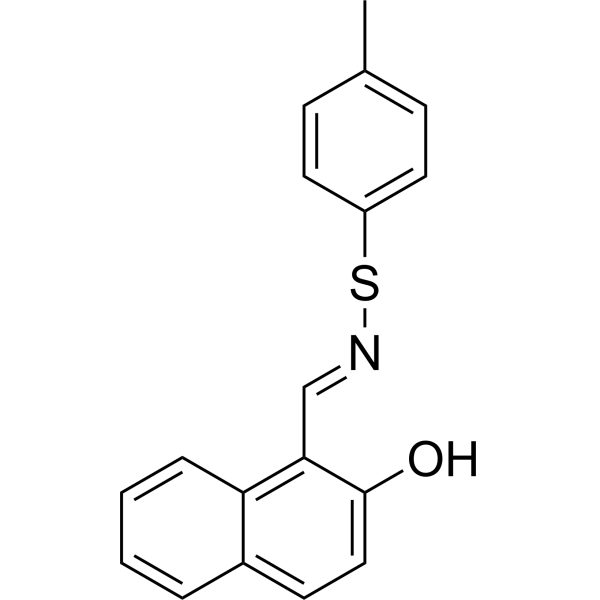
COH34
CAS No. 906439-72-3
COH34( -[(E)-(4-methylphenyl)sulfanyliminomethyl]naphthalen-2-ol )
Catalog No. M26126 CAS No. 906439-72-3
COH34 is a selective inhibitor of PARG with an IC50 of 0.37 nM and a Kd of 0.547 μM. COH34 prolongs PARylation at DNA lesions and traps DNA repair factors.
Purity : >98% (HPLC)
 COA
COA
 Datasheet
Datasheet
 HNMR
HNMR
 HPLC
HPLC
 MSDS
MSDS
 Handing Instructions
Handing Instructions
| Size | Price / USD | Stock | Quantity |
| 5MG | 260 | Get Quote |


|
| 10MG | 410 | Get Quote |


|
| 25MG | 678 | Get Quote |


|
| 50MG | 954 | Get Quote |


|
| 100MG | 1287 | Get Quote |


|
| 200MG | Get Quote | Get Quote |


|
| 500MG | Get Quote | Get Quote |


|
| 1G | Get Quote | Get Quote |


|
Biological Information
-
Product NameCOH34
-
NoteResearch use only, not for human use.
-
Brief DescriptionCOH34 is a selective inhibitor of PARG with an IC50 of 0.37 nM and a Kd of 0.547 μM. COH34 prolongs PARylation at DNA lesions and traps DNA repair factors.
-
DescriptionCOH34 is a selective inhibitor of PARG with an IC50 of 0.37 nM and a Kd of 0.547 μM. COH34 prolongs PARylation at DNA lesions and traps DNA repair factors.(In Vitro):COH34 potently inhibits PARP inhibitor-resistant cancer cells.(In Vivo):COH34 shows antitumor activity in xenograft mouse cancer models.
-
In VitroCOH34 efficiently kills PARP inhibitor-resistant cancer cells.
-
In VivoCOH34 induces lethality in cancer cells with DNA repair defects and exhibits antitumor activity in xenograft mouse cancer models.
-
Synonyms-[(E)-(4-methylphenyl)sulfanyliminomethyl]naphthalen-2-ol
-
PathwayOthers
-
TargetOther Targets
-
RecptorCytidine deaminase
-
Research Area——
-
Indication——
Chemical Information
-
CAS Number906439-72-3
-
Formula Weight293.38
-
Molecular FormulaC18H15NOS
-
Purity>98% (HPLC)
-
SolubilityIn Vitro:?DMSO : 16.67 mg/mL (56.82 mM)
-
SMILESCc1ccc(S\N=C\c2c(O)ccc3ccccc23)cc1
-
Chemical Name——
Shipping & Storage Information
-
Storage(-20℃)
-
ShippingWith Ice Pack
-
Stability≥ 2 years
Reference
1.Funamizu N, et al. Tetrahydrouridine inhibits cell proliferation through cell cycle regulation regardless of cytidine deaminase expression levels. PLoS One. 2012;7(5):e37424.
molnova catalog



related products
-
Dabsyl chloride
Dabsyl chloride is an amine derivatizing agent and able to give rise to stable products that can be easily monitored spectrophotometrically at 460 nm.
-
N-(6-chloro-5-(2-Met...
N-(6-chloro-5-(2-Methoxyphenoxy)-2-(pyridin-4-yl)pyriMidin-4-yl)-5-Methylpyridine-2-sulfonamide is a chemical agent.
-
Siaresinolic acid 28...
Siaresinolic acid 28-O-β-D-glucopyranosyl ester is a natural product for research related to life sciences.



 Cart
Cart
 sales@molnova.com
sales@molnova.com


